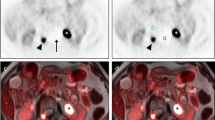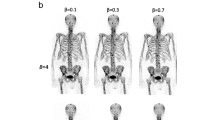Abstract
Purpose
Accurate attenuation correction (AC) is essential for quantitative analysis of PET tracer distribution. In MR, the lack of cortical bone signal makes bone segmentation difficult and may require implementation of special sequences. The purpose of this study was to evaluate the need for accurate bone segmentation in MR-based AC for whole-body PET/MR imaging.
Methods
In 22 patients undergoing sequential PET/CT and 3-T MR imaging, modified CT AC maps were produced by replacing pixels with values of >100 HU, representing mostly bone structures, by pixels with a constant value of 36 HU corresponding to soft tissue, thereby simulating current MR-derived AC maps. A total of 141 FDG-positive osseous lesions and 50 soft-tissue lesions adjacent to bones were evaluated. The mean standardized uptake value (SUVmean) was measured in each lesion in PET images reconstructed once using the standard AC maps and once using the modified AC maps. Subsequently, the errors in lesion tracer uptake for the modified PET images were calculated using the standard PET image as a reference.
Results
Substitution of bone by soft tissue values in AC maps resulted in an underestimation of tracer uptake in osseous and soft tissue lesions adjacent to bones of 11.2 ± 5.4 % (range 1.5–30.8 %) and 3.2 ± 1.7 % (range 0.2–4 %), respectively. Analysis of the spine and pelvic osseous lesions revealed a substantial dependence of the error on lesion composition. For predominantly sclerotic spine lesions, the mean underestimation was 15.9 ± 3.4 % (range 9.9–23.5 %) and for osteolytic spine lesions, 7.2 ± 1.7 % (range 4.9–9.3 %), respectively.
Conclusion
CT data simulating treating bone as soft tissue as is currently done in MR maps for PET AC leads to a substantial underestimation of tracer uptake in bone lesions and depends on lesion composition, the largest error being seen in sclerotic lesions. Therefore, depiction of cortical bone and other calcified areas in MR AC maps is necessary for accurate quantification of tracer uptake values in PET/MR imaging.





Similar content being viewed by others

References
Hofmann M, Pichler B, Scholkopf B, Beyer T. Towards quantitative PET/MRI: a review of MR-based attenuation correction techniques. Eur J Nucl Med Mol Imaging. 2009;36 Suppl 1:S93–S104. doi:10.1007/s00259-008-1007-7.
Burger C, Goerres G, Schoenes S, Buck A, Lonn AH, Von Schulthess GK. PET attenuation coefficients from CT images: experimental evaluation of the transformation of CT into PET 511-keV attenuation coefficients. Eur J Nucl Med Mol Imaging. 2002;29(7):922–7. doi:10.1007/s00259-002-0796-3.
Beyer T, Weigert M, Quick HH, Pietrzyk U, Vogt F, Palm C, et al. MR-based attenuation correction for torso-PET/MR imaging: pitfalls in mapping MR to CT data. Eur J Nucl Med Mol Imaging. 2008;35(6):1142–6. doi:10.1007/s00259-008-0734-0.
Hofmann M, Steinke F, Scheel V, Charpiat G, Farquhar J, Aschoff P, et al. MRI-based attenuation correction for PET/MRI: a novel approach combining pattern recognition and atlas registration. J Nucl Med. 2008;49(11):1875–83. doi:10.2967/jnumed.107.049353.
Martinez-Möller A, Souvatzoglou M, Delso G, Bundschuh RA, Chefd'hotel C, Ziegler SI, et al. Tissue classification as a potential approach for attenuation correction in whole-body PET/MRI: evaluation with PET/CT data. J Nucl Med. 2009;50(4):520–6. doi:10.2967/jnumed.108.054726.
Schulz V, Torres-Espallardo I, Renisch S, Hu Z, Ojha N, Bornert P, et al. Automatic, three-segment, MR-based attenuation correction for whole-body PET/MR data. Eur J Nucl Med Mol Imaging. 2011;38(1):138–52. doi:10.1007/s00259-010-1603-1.
Hofmann M, Bezrukov I, Mantlik F, Aschoff P, Steinke F, Beyer T, et al. MRI-based attenuation correction for whole-body PET/MRI: quantitative evaluation of segmentation- and atlas-based methods. J Nucl Med. 2011;52(9):1392–9. doi:10.2967/jnumed.110.078949.
Keereman V, Fierens Y, Broux T, De Deene Y, Lonneux M, Vandenberghe S. MRI-based attenuation correction for PET/MRI using ultrashort echo time sequences. J Nucl Med. 2010;51(5):812–8. doi:10.2967/jnumed.109.065425.
Robson MD, Bydder GM. Clinical ultrashort echo time imaging of bone and other connective tissues. NMR Biomed. 2006;19(7):765–80. doi:10.1002/nbm.1100.
Schwartz J, Humm JL, Gonen M, Kalaigian H, Schoder H, Larson SM, et al. Repeatability of SUV measurements in serial PET. Med Phys. 2011;38(5):2629–38.
Burger IA, Huser DM, Burger C, von Schulthess GK, Buck A. Repeatability of FDG quantification in tumor imaging: averaged SUVs are superior to SUVmax. Nucl Med Biol. 2012; in press. doi:10.1016/j.nucmedbio.2011.11.002
Schleyer PJ, Schaeffter T, Marsden PK. The effect of inaccurate bone attenuation coefficient and segmentation on reconstructed PET images. Nucl Med Commun. 2010;31(8):708–16. doi:10.1097/MNM.0b013e32833b0573.
Eiber M, Martinez-Moller A, Souvatzoglou M, Holzapfel K, Pickhard A, Loffelbein D, et al. Value of a Dixon-based MR/PET attenuation correction sequence for the localization and evaluation of PET-positive lesions. Eur J Nucl Med Mol Imaging. 2011;38(9):1691–701. doi:10.1007/s00259-011-1842-9.
Catana C, van der Kouwe A, Benner T, Michel CJ, Hamm M, Fenchel M, et al. Toward implementing an MRI-based PET attenuation-correction method for neurologic studies on the MR-PET brain prototype. J Nucl Med. 2010;51(9):1431–8. doi:10.2967/jnumed.109.069112.
Acknowledgments
The authors thank Albert Lonn for useful discussions.
Research support
This work was supported in part by a research grant from GE Healthcare, Waukesha, WI, USA.
Conflicts of interest
One of the authors (S.W.) is an employee of GE HealthCare, Waukesha WI, USA.
The research group receives research support from GE Healthcare.
Author information
Authors and Affiliations
Corresponding author
Rights and permissions
About this article
Cite this article
Samarin, A., Burger, C., Wollenweber, S.D. et al. PET/MR imaging of bone lesions – implications for PET quantification from imperfect attenuation correction. Eur J Nucl Med Mol Imaging 39, 1154–1160 (2012). https://doi.org/10.1007/s00259-012-2113-0
Received:
Accepted:
Published:
Issue Date:
DOI: https://doi.org/10.1007/s00259-012-2113-0



